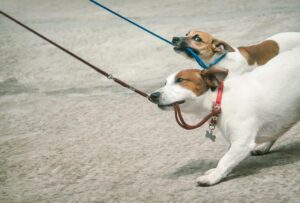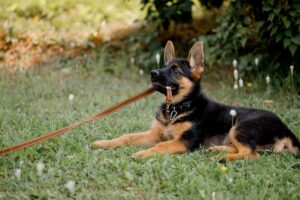If your dog frequently bites, chews, or tugs at the leash during walks, you’re not alone. Many dog owners experience this behavior, and while it may seem harmless or even cute at first, it can quickly turn into frustration. More importantly, if your dog learns to chew through the leash, it might break free, putting it in real danger. Leash biting can also be a sign of underlying tension or overstimulation.
Fortunately, with the right training techniques and patience, you can teach your dog to remain calm and focused during walks. In this guide, we’ll explore why dogs bite their leashes, the possible causes behind the behavior, and step-by-step solutions to help you correct it.
Why Does My Dog Bite the Leash While Walking?
Understanding why your dog bites or chews the leash is the first step toward correcting the behavior. Dogs engage in this action for a variety of reasons, including excitement, frustration, anxiety, or even a learned habit.
The Leash Feels Like a Toy
 For many dogs, especially puppies, the leash appears to be just another chewable object. Since it’s always nearby during walks, it’s easy for them to grab onto it and treat it like a tug toy. Puppies in particular love exploring things with their mouths, and if they haven’t been trained otherwise, they may see the leash as nothing more than an interesting object to chew.
For many dogs, especially puppies, the leash appears to be just another chewable object. Since it’s always nearby during walks, it’s easy for them to grab onto it and treat it like a tug toy. Puppies in particular love exploring things with their mouths, and if they haven’t been trained otherwise, they may see the leash as nothing more than an interesting object to chew.
Excitement and Overstimulation
For energetic dogs, walking is one of the most exciting things that happens in their daily routine. When they see the leash, it signals adventure, exploration, and fun, leading them to “express” their excitement by grabbing it. This is especially common in young dogs or high-energy breeds that have a hard time staying calm before and during a walk.
Anxiety or Frustration
Some dogs bite the leash out of nervousness or frustration. This behavior is often seen in shelter dogs, who may associate leash attachment with overstimulation or confinement. Dogs that become overly aroused when going outside—especially in stimulating environments with lots of smells, people, and other dogs—may use leash biting as a way to release stress.
Lack of Proper Leash Training
If a dog has never been properly introduced to a leash, it may grab onto it because it doesn’t know what else to do. Without clear direction about how to behave, a dog may start playing with the leash or pulling on it for attention.
Discomfort from the Collar or Harness
If your dog’s collar or harness is too tight, rough, or irritating, they may bite and tug at the leash as a way of expressing discomfort. If your dog only bites the leash when wearing certain equipment, consider checking the fit and looking for any signs of chafing or irritation.
How to Prevent Leash Biting While Walking
Thankfully, leash biting is a behavior that can be corrected with patience and consistent training. Teaching your dog proper leash manners will not only make your walks more enjoyable but will also ensure your dog remains safe and focused.
Step 1: Teach Your Dog to Stay Calm at the Sight of the Leash
The first step to preventing leash biting is getting your dog to associate the leash with calm behavior rather than excitement or playtime.
Begin training when your dog is already exercised and less energetic to set them up for success.
 Have small treats ready to reward calm behavior.
Have small treats ready to reward calm behavior.- Touch the leash while it hangs on a hook or rests on a table without picking it up.
- If your dog remains calm while observing the leash, reward them with a treat.
- If they get excited, take your hand away and withhold the treat. Repeat until your dog remains calm.
- Gradually progress to picking up the leash, rewarding calm behavior, and ignoring any signs of excitement.
This step may take a few practice sessions, but with time, your dog will learn that staying calm earns treats and attention while excited behavior does not.
Step 2: Attach the Leash Only When Your Dog is Calm
Once your dog remains relaxed while you hold the leash, teach them the next step: sitting still while you attach it.
- Ask your dog to sit before clipping on the leash.
- If they remain seated without jumping or grabbing at the leash, give them a treat and praise.
- If they try to grab the leash or move, immediately put it down and wait for them to settle before trying again.
This teaches your dog that the faster they calm down, the sooner they get to go on their walk.
Step 3: Reward Calm Walking Behavior
Once you’re outside, reinforce leash manners by rewarding your dog for walking calmly by your side.
- If your dog walks without biting the leash, praise and reward them with treats or verbal affirmation.
- If they start mouthing the leash, stand still and ignore them until they stop, then resume walking. This teaches them that biting the leash means no forward movement.
- Some dogs respond well to holding a different object, such as a favorite toy, to satisfy their urge to carry something in their mouth.
Step 4: Introduce an Alternative Behavior
Instead of punishing your dog for biting the leash, give them an alternative behavior that is more rewarding.
- Carry a chew toy or rope toy on your walk and offer it as a replacement when they reach for the leash.
- You can also teach a “leave it” or “drop it” command, rewarding your dog for letting go of the leash when asked.
Step 5: Keep Walks Structured and Calm
If your dog gets too excited when leaving the house, consider adjusting your pre-walk routine to reduce excess energy.
- Allow some playtime or exercise before the actual walk.
- Start the walk at a moderate pace; avoid rushing out the door.
- Maintain a calm demeanor while handling the leash—dogs often mirror their handlers’ energy.
When to Seek Professional Help
 If you’ve tried multiple training techniques but your dog continues to bite, tug, or destroy leashes, it may be time to consult a professional dog trainer or behaviorist. Some dogs develop strong leash aggression or frustration, making it challenging for owners to correct on their own. Professional guidance can help identify the root cause and provide tailored solutions.
If you’ve tried multiple training techniques but your dog continues to bite, tug, or destroy leashes, it may be time to consult a professional dog trainer or behaviorist. Some dogs develop strong leash aggression or frustration, making it challenging for owners to correct on their own. Professional guidance can help identify the root cause and provide tailored solutions.
Enjoy Stress-Free Walks with Your Dog
By consistently reinforcing calm behavior and using positive training techniques, your dog can learn to walk nicely on a leash without biting or tugging. Remember to stay patient and reward progress along the way.
If you need help ensuring your dog gets regular, well-structured walks from experienced handlers, Paw Pals Pet Sitting offers professional dog walking services tailored to your dog’s needs. Contact us today to schedule expert care for your furry friend.


